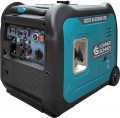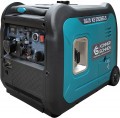Fuel
The type of fuel that the generator's engine runs on.
—
Gasoline. One of the main types of fuel for internal combustion engines. Gasoline generators are usually cheaper than diesel generators, all other things being equal, but they are more expensive to run due to the higher price of gasoline; in addition, they usually have a shorter resource than diesel ones. Therefore, it is believed that gasoline generators are well suited primarily as a backup power source in case of a power outage.
—
Diesel. Diesel generators are usually more expensive than their gasoline counterparts; on the other hand, diesel fuel is cheaper than gasoline, so the increased cost may well pay off with regular use. In addition, diesel generators have a longer resource and a larger power range than gasoline ones. This allows them to be used as both backup and main power sources, including at rather "energy-intensive" objects.
—
Gas. The advantages of gas-fired generators are relatively low noise levels and low emissions. On the other hand, the use of gas as a fuel is associated with certain difficulties: it is necessary to connect to a gas pipeline or regularly replace special cylinders, the fuel system is especially sensitive to leaks, etc. Therefore, there are relatively few such models produced, and most of them are stationary high power generators, in which the mentioned disa
...dvantages are covered by the advantages.
- Gasoline / gas. Models capable of using both types of fuel indicated. This gives the user the opportunity to choose the option that best suits a particular situation, and also reduces the likelihood of being left without fuel at the most inopportune moment; on the other hand, such models are more expensive than single-fuel ones. The technical features of gasoline and gas are described in detail above.Functions
-
DC output (DC 12 V). The presence in the generator of an output with direct power and a voltage of 12 V. The main function of this output is to charge car batteries, as well as power devices originally intended for cars (remember, 12 V is the standard voltage of on-board networks in passenger cars).
-
USB port for charging. The generator has a USB connector (one or more) for charging various devices. Most modern smartphones and tablets can be charged from USB; this charging method is also found in many other equipment - from cameras and flashlights to electric screwdrivers and radio-controlled models. The standard supply voltage through this connector is 5 V, but the power may vary and should be specified separately.
-
Synchronization with a smartphone. Synchronization with a smartphone allows you to control the operation of the generator remotely. Thanks to this, the user does not need to approach the device to, for example, start or stop it. Additionally, synchronization with a smartphone allows you to monitor the parameters of the generated electric power remotely and in real time. On the other hand, this will require a constant connection to the Internet and specialized software that must be installed on your smartphone.
-
Autorun (ATS). A function that allows the generator to turn on automatically under
...certain conditions, without user action. Autostart is used mainly when using a generator as a backup power source: while the main power is on, the unit is turned off, and if the mains voltage disappears, the ATS starts the engine, and power to the load begins to flow from the generator. Note that the presence of autostart is indicated only if the generator is initially equipped with an ATS electronic unit; models with the ability to connect such a unit are placed in a separate category (see below).
- Connector for the ATS block. A connector that allows you to connect an external autorun unit (ATS) to the generator; The block itself is not included. See above for more details on autorun; We note here that for some users this function is not initially needed, but it may be needed in the future - for example, if the generator is initially used in the construction of a house, and then it is planned to be installed in the same house as a backup power source. In such situations, this configuration option will be optimal: when purchasing the generator itself, you will not have to overpay for the ATS unit, and later, if necessary, you can buy and connect such a unit separately.
- Automatic voltage regulator (AVR). An automatic regulator that allows you to maintain a constant voltage level at the generator output. Such a regulator smoothes out differences arising from changes in engine rotation speed; This is especially important when connecting devices that are sensitive to power stability. It is worth noting that the presence of AVR is practically mandatory for synchronous generators (see “Alternator”), but in other varieties this function is not found: in asynchronous and duplex units it is not applicable in principle, and in inverter units the role of the regulator is played by the inverter itself, and they do not require additional electronics.
— Display. Own display mounted on the generator body. As a rule, this is a simple LCD screen that can only display numbers and some special characters. However, even such a screen can display various useful information: voltage, frequency, hour meter data, low fuel level warning, failure messages with error codes, etc. Thanks to this, control becomes more convenient and visual.
- Hour meter. A device that counts the total time that the electric generator engine has worked since it was first turned on. This helps to determine the general wear and tear of the engine and the need for its repair/replacement, which can be useful both when using the device for a long time, and, for example, to assess the quality of the product when purchasing a used electric generator. It is usually impossible to reset the hour meter without serious intervention in the design of the device.
— Voltmeter. A device that displays the power voltage output by the generator. The voltmeter can be made in the form of a separate dial scale, or its readings can be displayed on the generator’s own display (see above). In any case, this function allows you to carefully control the operating mode of the unit and reduces the risk that unacceptable voltage will be applied to the load.
- Parallel connection. The presence in the design of the generator of special connectors through which two or more units can be connected to a single electrical network (usually with the help of an additional device). This type of connection is used when one unit is not able to pull the entire load and the connection power exceeds the capabilities of the device itself. Also, a similar scheme has found popularity if one of the units is planned to be used as a backup power source.
- Remote start. Presence in a set of delivery of the generator of the remote control. It is made in the form of a wireless key fob and allows you to turn on/off the device from a distance without going near it.Weight
The total weight of the unit - as a rule, excluding fuel; The full fill weight can be easily determined by knowing the tank capacity.
In general, more powerful generators inevitably turn out to be heavier, but models with similar characteristics can differ noticeably in weight. When assessing these differences and generally choosing an option based on weight, it is worth taking into account the specific application of the generator. So, if the device will often be moved from place to place - for example, when used “on the road” - it may be worth paying attention to lighter units that are more convenient to transport. However, it is worth considering that the downside of a lightweight design is often an increased cost or a reduced degree of protection. But for stationary use, you can not pay much attention to this parameter - or even the opposite: choose a heavier (and, as a rule, more advanced and functional) option.
Regarding specific numbers, it is worth noting that modern generators in general are quite massive. So, a small weight for such equipment is considered not only
up to 20 kg, but even
20 – 30 kg ; Many units weigh
150–200 kg, or even
more, and the weight of stationary industrial models is already measured in tons.

